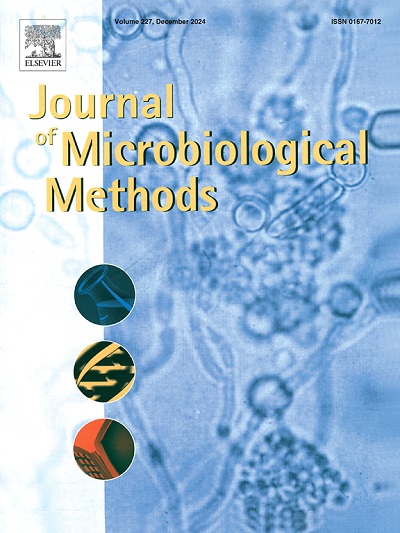The development of a subunit vaccine for Mycobacterium tuberculosis Rv0081 as a booster for BCG and the investigation of its immunogenicity
IF 1.9
4区 生物学
Q4 BIOCHEMICAL RESEARCH METHODS
引用次数: 0
Abstract
Tuberculosis (TB) is the number one infectious disease killer worldwide. Bacillus Calmette-Guérin (BCG) is the only vaccine currently used in clinical practice to prevent TB, but it still has limitations in preventing latent infection and reactivation of TB. The investigation focused on the selection of the Rv0081 antigen linked to latency, leading to the successful creation of the prokaryotic expression recombinant plasmid pET30b-Rv0081 for subsequent expression and purification processes. Antigen specificity was additionally validated through the implementation of whole blood IFN-γ release assay (WBIA), enzyme-linked immunosorbent assay (ELISA), and flow cytometry analysis. rRv0081 induced individuals infected with Mycobacterium tuberculosis (M. tb) to exhibit markedly elevated levels of IFN-γ in their peripheral blood compared to the control group of healthy individuals. Mice were co-immunized with rRv0081 and DMT, and serum specific antibodies, levels of cytokines secreted by splenocytes and the number of multifunctional T cells in splenocytes were detected. The study findings indicated a notable elevation in the secretion levels of IFN-γ, TNF-α, and IL-2 cytokines from splenocytes, along with increased levels of IgG and its subclasses in the serum of mice belonging to the BCG + rRv0081/DMT group compared to its control group. Furthermore, there was a significant increase in the count of single-positive and double-positive CD4+ and CD8+ T cells stimulated to generate IFN-γ and TNF-α in the BCG + rRv0081/DMT group when contrasted with the BCG group. This suggests that rRv0081/DMT could be a potential subunit vaccine candidate that may serve as an effective booster vaccine after primary immunization against BCG.
结核分枝杆菌Rv0081亚单位疫苗卡介苗增强剂的研制及其免疫原性研究
结核病(TB)是全球头号传染病杀手。卡介苗(Bacillus calmette - gusamrin, BCG)是目前临床用于预防结核病的唯一疫苗,但它在预防结核病潜伏感染和再激活方面仍有局限性。研究重点是选择与潜伏期相关的Rv0081抗原,成功构建了原核表达重组质粒pET30b-Rv0081,用于后续的表达和纯化过程。抗原特异性还通过全血IFN-γ释放试验(WBIA)、酶联免疫吸附试验(ELISA)和流式细胞术分析进行验证。与健康对照组相比,rRv0081诱导感染结核分枝杆菌(M. tb)的个体外周血中IFN-γ水平显著升高。用rRv0081和DMT共同免疫小鼠,检测血清特异性抗体、脾细胞分泌细胞因子水平和脾细胞多功能T细胞数量。研究结果表明,与对照组相比,BCG + rRv0081/DMT组小鼠脾细胞分泌IFN-γ、TNF-α和IL-2细胞因子水平显著升高,血清中IgG及其亚类水平升高。此外,与BCG组相比,BCG + rRv0081/DMT组刺激产生IFN-γ和TNF-α的单阳性和双阳性CD4+和CD8+ T细胞计数显著增加。这表明rRv0081/DMT可能是一种潜在的候选亚单位疫苗,可作为卡介苗初次免疫后有效的加强疫苗。
本文章由计算机程序翻译,如有差异,请以英文原文为准。
求助全文
约1分钟内获得全文
求助全文
来源期刊

Journal of microbiological methods
生物-生化研究方法
CiteScore
4.30
自引率
4.50%
发文量
151
审稿时长
29 days
期刊介绍:
The Journal of Microbiological Methods publishes scholarly and original articles, notes and review articles. These articles must include novel and/or state-of-the-art methods, or significant improvements to existing methods. Novel and innovative applications of current methods that are validated and useful will also be published. JMM strives for scholarship, innovation and excellence. This demands scientific rigour, the best available methods and technologies, correctly replicated experiments/tests, the inclusion of proper controls, calibrations, and the correct statistical analysis. The presentation of the data must support the interpretation of the method/approach.
All aspects of microbiology are covered, except virology. These include agricultural microbiology, applied and environmental microbiology, bioassays, bioinformatics, biotechnology, biochemical microbiology, clinical microbiology, diagnostics, food monitoring and quality control microbiology, microbial genetics and genomics, geomicrobiology, microbiome methods regardless of habitat, high through-put sequencing methods and analysis, microbial pathogenesis and host responses, metabolomics, metagenomics, metaproteomics, microbial ecology and diversity, microbial physiology, microbial ultra-structure, microscopic and imaging methods, molecular microbiology, mycology, novel mathematical microbiology and modelling, parasitology, plant-microbe interactions, protein markers/profiles, proteomics, pyrosequencing, public health microbiology, radioisotopes applied to microbiology, robotics applied to microbiological methods,rumen microbiology, microbiological methods for space missions and extreme environments, sampling methods and samplers, soil and sediment microbiology, transcriptomics, veterinary microbiology, sero-diagnostics and typing/identification.
 求助内容:
求助内容: 应助结果提醒方式:
应助结果提醒方式:


